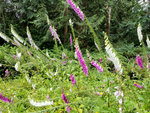

The list of plants that can harm you, your child or your pet is enough to strike terror into any heart. Hemlock was famously used to execute Socrates. Deadly nightshade, mistaken for edible berries, has killed unwitting foragers. Bittersweet nightshade with its clusters of tempting red berries is less toxic but common on the Key Peninsula. The rash from poison oak has tortured many an unsuspecting hiker. But plants like rhododendrons, daffodils, daphne — how much of a danger do these garden stalwarts pose?
Dr. Erica Liebelt, executive and medical director of the nonprofit Washington Poison Center, said that most plants are not as toxic as you might think. But some basic knowledge and precautions can prevent ill effects.
Liebelt said that calls about plant toxicity are common, particularly for children 12 and under. Most serious toxic exposures, though, are to adults who are foraging and have confused edible plants with toxic ones.
Recent calls to WAPC included a woman who ate a fall crocus, thinking it was a wild onion and had nausea and abdominal pain within an hour. One family ate young leaves from foxglove, thinking they were enjoying a salad of dandelion greens. The entire plant contains digitalis, which has been used for centuries to treat heart failure and rhythm problems, but in toxic doses it will cause a slow heart rate, nausea, vomiting and even death. Poison hemlock and water hemlock, probably the most poisonous of plants that grow on the KP, can be confused with wild parsley and wild parsnip. Though deaths have occurred with accidental ingestion, Liebelt has not heard of any since she joined the WAPC in 2016.
The toxins that plants produce are part of their defense system. Rooted in place, they are not able to run from predators. They have evolved protective measures such as thorns, thick bark, stinging hairs and indigestible leaves to thwart their natural enemies. They also have developed toxins to protect themselves from fungi, insects and other animals.
Toxins are often in all parts of the plant but may be more concentrated in one part than others, and sometimes how much is present will vary with how young or mature the plant part is. Young leaves or immature fruit often have higher levels of toxin than when they are mature. And some plants have edible fruit but toxic leaves or stems.
Liebelt thinks about plants in terms of what part of the body is affected by their toxins.
Foxglove, larkspur, lily of the valley and oleander all affect the heart. Other plant toxins affect the nervous system by either blocking or over-stimulating transmission of signals to the nerves. Hemlock, unrelated to the Western hemlock tree, kills by causing respiratory paralysis. The toxin from nectar in azalea and rhododendron flowers can cause sleepiness and stomach irritation.
Many plants affect the gastrointestinal system, causing nausea, vomiting and sometimes diarrhea. Daffodil, tulip, hyacinth and iris bulbs can all cause stomach upset, though their toxicity is considered to be mild.
Author Amy Stewart described what she calls botanical crime families in her book “Wicked Plants: The Weed that Killed Lincoln’s Mother and Other Botanical Atrocities.” The nightshade family that includes deadly nightshade also includes tomatoes, potatoes, peppers and eggplants. Pierce County Master Gardener Dale Skrivanich said it is important to remember that the leaves and stems of tomato and potato plants (and potatoes that have turned green) contain a toxin that can make you sick. The carrot family encompasses plants that are staples in any kitchen – carrots, parsnips, dill, parsley, but also some of the most toxic — hemlock (again, no relation to the tree), and giant hogweed.
Liebelt said that it is hard to depend on lists of plants as those lists are never complete. The WAPC welcomes calls if there is any concern about exposure. If you know the names of plants in your garden or home it can help clarify the risk. And for children prevention is preferred. “Look don’t lick. Admire don’t pick” is the WAPC mantra.
Poison information is available at WAPC 24 hours a day, seven days a week at 800-222-1222.
UNDERWRITTEN BY THE FUND FOR NONPROFIT NEWS (NEWSMATCH) AT THE MIAMI FOUNDATION, THE ANGEL GUILD, ADVERTISERS, DONORS AND PEOPLE WHO SUPPORT INDEPENDENT, NONPROFIT LOCAL NEWS